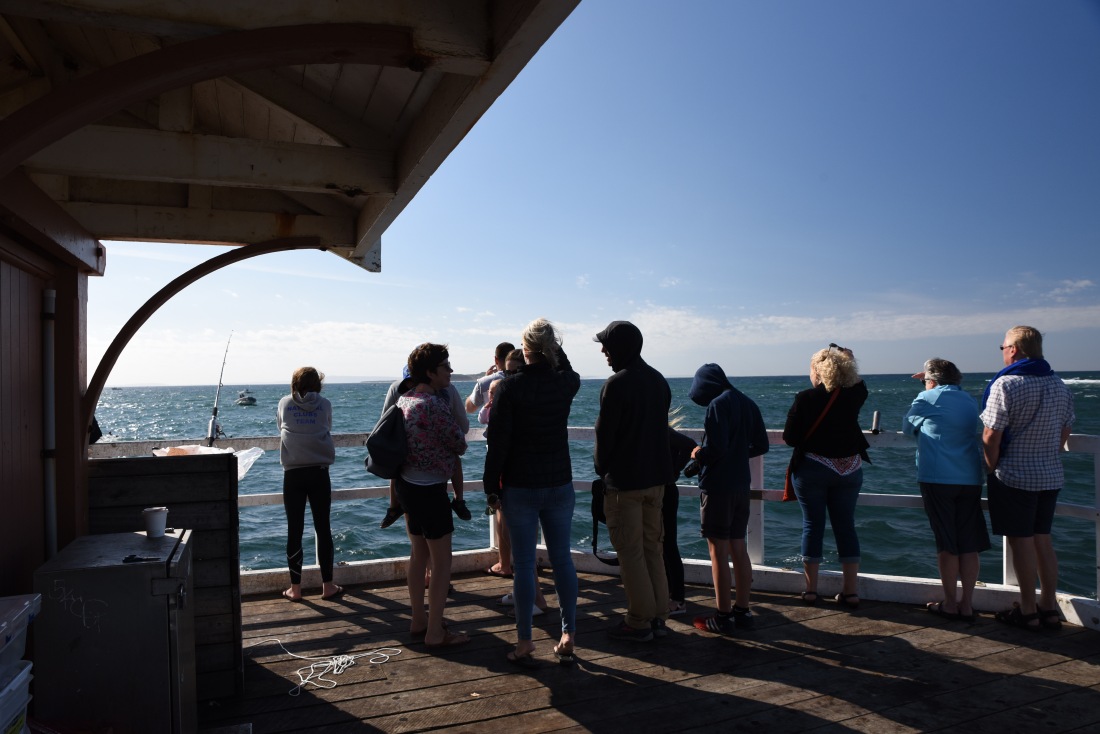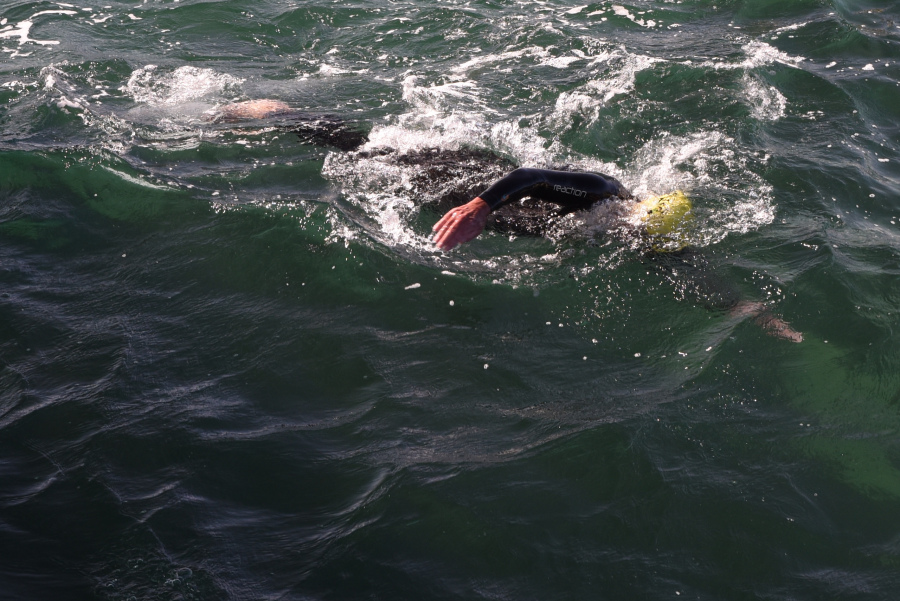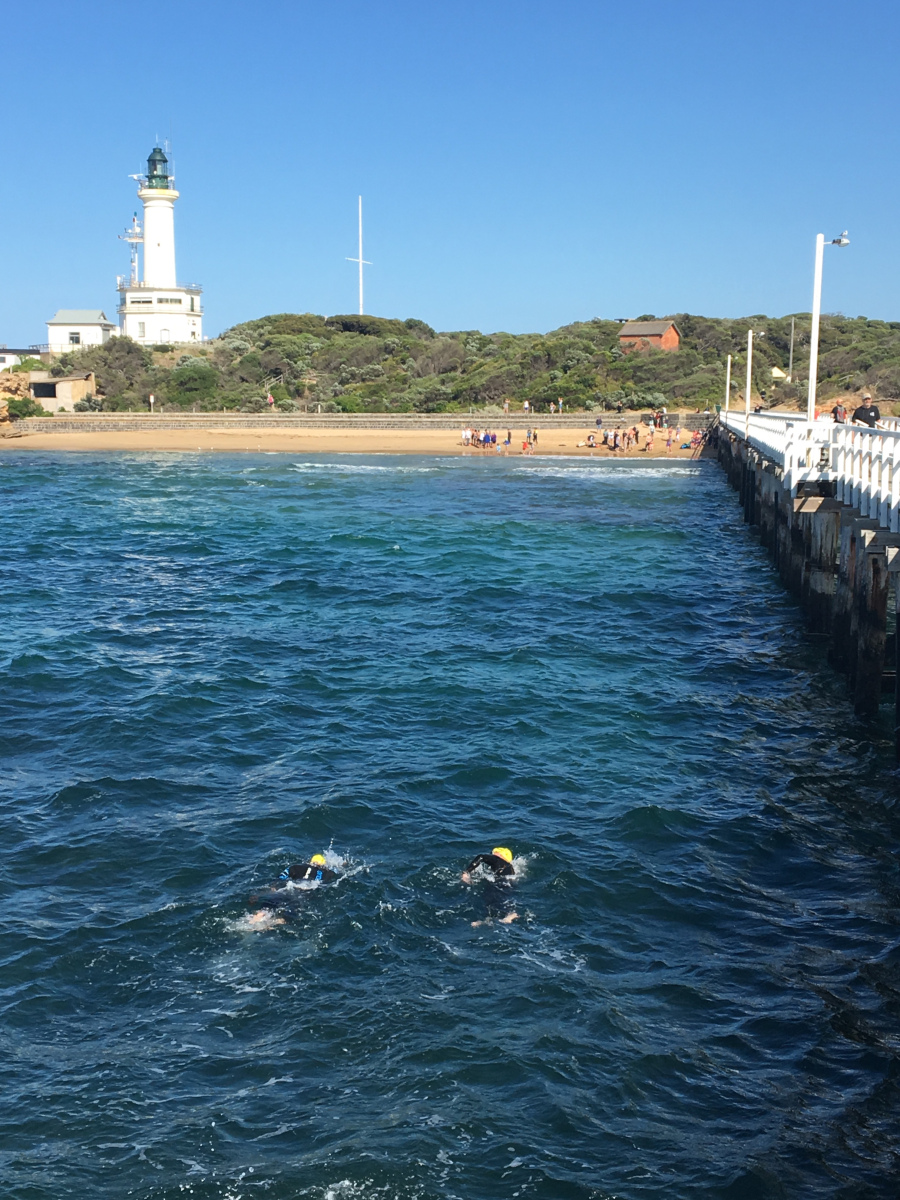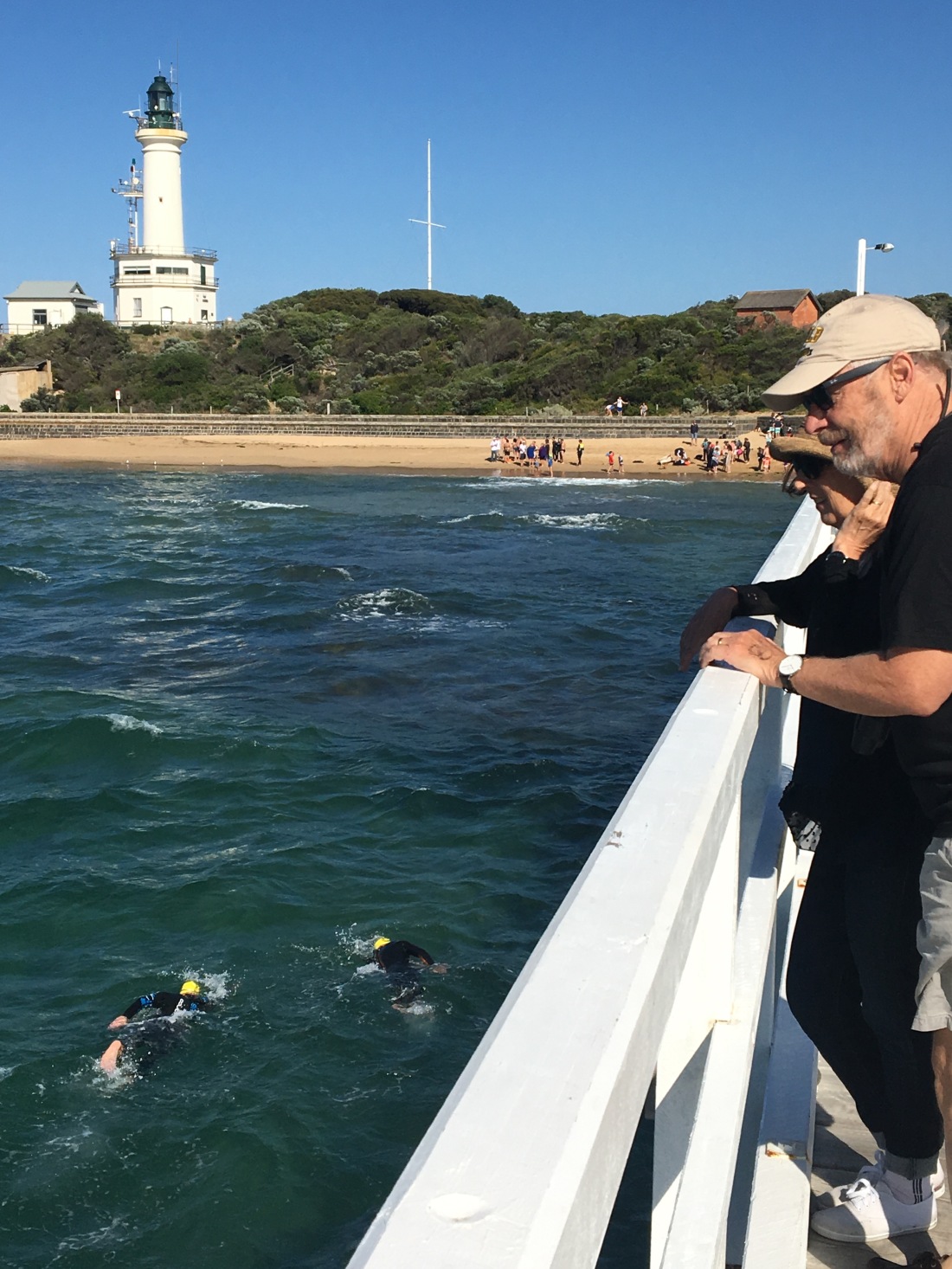One year ago to the day I swam from a deep water start just north of Point Nepean, across the Rip to Point Lonsdale lighthouse beach. The shortest distance between those points is 3.2kms, the distance I swam was 4.6kms, but the journey to me was much more than the distance.
I have done longer and faster swims since my Rip crossing on 26 February 2017, but I think that swim across the notorious entrance to Port Phillip Bay (Victoria, Australia) is etched in my memory as the most memorable swim I have ever done.
Having grown up in Victoria, I have always known the reputation of the Rip, that it has claimed ships and lives, and that it is a treacherous body of water for boats and even for large ocean going ships. Apart from the lives of sailor and passengers lost in shipwrecks, Harold Holt (Prime Minister of Australia) disappeared at sea while snorkelling just around the corner from Pt Nepean at Cheviot Beach. Then there was the army night exercise in the Rip many decades ago that went wrong with loss of lives. Nobody swam across the Rip until 1971 (Doug Mew did it, with single boat escort – in the opposite direction to my swim). There are times when the current in the Rip is too strong for small boats and yachts to make headway against it. Corsair Rock on the ocean side of Pt Nepean is a famous hard core surf break, talked of by far greater numbers than have ever or will ever surf it. I can recall fishing at night with my father and grandfather off the Pt Lonsdale jetty, as breaking surf rose and fell alarmingly beneath the rickety planks. I distinctly recall thinking that to fall off that jetty would be to die. At that age and time, I was no doubt right.
The mystique of the Rip is added to by tales of pirate Benito Benita’s treasure from the Spanish Main being buried in the area in the late 1700s. The wild white man John Buckley is said to have occupied ‘Buckley’s cave’ in the early 1800s, just below the southern aspect of the lighthouse. I played in this cave as a boy, but it is now sealed up. The Rip is a place around which fact and legend swirl. For a non-Victoria ignorant of all that ‘the Rip’ conjures up for we locals, the swim might just be a rough 3.2kms with interesting seas and currents. For me, swimming across it was something to be tackled with respect and more than a little uncertainty.
I can recall standing near the Pt Lonsdale lighthouse at quite a young age and learning from my aging grandfather that the wreck in the distance was a steam vessel (‘The Time’) which met its end on a reef on the Pt Nepean side of the heads. Incoming large ships are not permitted to pass through this narrow entrance without a local pilot in charge. The pilot is ferried to the ship outside the heads in a specialised all-weather pilot vessel. In bad weather the ship positions so one side is facing the weather, and the other presents a temporary lee area where a sometimes perilous transfer involving rope ladders occurs. On such days, locals often gather on the headland near the Pt Lonsdale lighthouse to watch the pilot boat’s passage and the pilot transfer to the ship. A related pastime is watching large ships pitch and roll as they pass through the Rip.

This picture shows the pilot vessel in the Rip on a rough day.
The entrance to Port Phillip bay is so narrow, that on low tide, the associated slack water is deferred by a period of 2-3 hours. Tidal streams in the 5-8 knot range regularly flow through the heads. The water in the middle is nearly 300 feet deep, and much shallower with reefs on either side.
I am merely a journeyman swimmer. For a long time I wasn’t even that. In my 20s I gained my surf life saving Bronze Medallion at Torquay, but my swimming stroke was based more on energy and youth than sound technique. In the 1990s I returned to longboarding. I decided one day out the back in sizeable surf at Torquay that all things considered about my swimming prowess at that stage, a leg rope was really all that was between me and the end of me. So I took to the pool to get at least a 1000m non-stop swim under my belt. It took quite a while.
I decided to ocean-test what I thought was my new stroke by entering some organised ocean swimming races. I started with the now famous Pier to Pub 1200m ocean swim at Lorne, Victoria. It now attracts 5,000 competitors every January. There were very few competitors who took longer than I did. I recall taking over 40 minutes to finish one P2P. I won’t list the other races and locations where I achieved similar results. Suffice to say that on more than one occasions I have received the unwelcome applause of the crowd as the rescue craft follow me to the beach with all other swimmers out of the water and watching. It wasn’t that I was unfit, it was simply that my freestyle technique was entirely deficient.
So I eventually decided to make a point of understanding more about freestyle technique. I bought books, I searched the internet, I watched Youtube videos, I had a few one-on-one coaching sessions (mostly with the wrong coaches, until relatively recently when I found exactly the right coach) and I asked and carefully observed those who swam better than me (which was most people moving in water out of their depth). I went to the pool and did the drills, had photos and videos taken of me which primarily taught me that what I thought my body was doing in the water bore no relation to what the camera revealed was actually going on.
I persisted and gradually homed in on a couple of schools of thought on the topic, and eventually distilled what I thought was the modern consensus on how to swim freestyle efficiently. My stroke slowly improved. I learned that there is no single magic bullet, but simply a whole lot of minor things which add up to produce major changes in efficiency. I reckon I’m on the right track now.
I learned that for ocean swimming kicking is not a useful contributor to thrust. I now use a light two beat kick. I learned that working on the catch and pull wasn’t much use until my body balance and streamlining were in order. Then I learned about the many intricacies of the fully efficient catch and pull. I am still working my way through that list. My stroke rate went from the 40s initially, then up to the 50s for a year or two. It is currently in the 58-64 stroke per minute range. My time per km went from 23-24 minutes, down to frequent 19 to 19:30 minute kms, with the occasional 18:50 or so thrown in. These times are all on out and back swims so that the current is with me and against me for equal distance. I plan to continue improving my speed. My best Pier to Pub time is 17:30 (one way swim & current assisted I must confess). I have done a few 5km swims in around 1:45.
My average pace on 26 February 2017 across the Rip was 1:51/100m (18:30/km) courtesy of powerful tidal currents on an outgoing tide and a 20 knot easterly wind on our tail with a following sea of whitecaps, made more interesting by a 2m SW swell rolling in through the heads. I did the swim with 5 others, a kayak escort, and other safety boats in the area (there were a number of other similarly sized groups doing the swim at the same time).

















It was a swim I never dreamed I’d be able to do. When I started my swimming mission in the 1990s my successes were measured in mere hundreds of metres. I would’ve been excited to go through the Rip in a boat. I had heard of the occasional swimmer doing the swim, but ranked them with Channel swimmers and the like. I registered for the swim with some trepidation, which continued right up until I jumped off the boat into a rough sea off Pt Nepean on Sunday morning a year ago. I trained long and hard, but still had misgivings on the day, especially with a strong tidal current (unexpected) and a following 20 knot easterly wind keeping up the wind waves and white caps. The 2m SW swell was opposing us, and produced interesting conditions mid-crossing. I was rapt to complete this crossing.
There is something about an A to B swim when A & B are well known geographic locations, and the distance between them is more of a famous geographic feature than a known distance. I recently did a 5km ocean swimming race around some buoys at Lorne (on the morning of the day of my 21st Pier to Pub swim). It doesn’t compare in any way with my swim across the Rip. The 5km race will fade and merge into all my other ocean swims at Lorne. But the Rip swim is the swim I will never forget.
For the record, I am about the 335th person to ever swim the Rip. For comparison approximately 4,400 people have climbed Mt Everest and 1,730 people have swum the English Channel. I am swimmer #235 on the honour board maintained by the organisers of the Rip swim.
February 26 2017 was a great day. I couldn’t let the first anniversary of my (only) swimming milestone pass without this reminiscence.
Ocean swimming has become an important part of my life. To all my swimming friends, thanks for the company on the journey.
It certainly was a great day for you and a wonderful achievement. It was so exciting waiting on the jetty! And, for your family and friends, another example of your enthusiasm and determination to achieve your goals. Well done, again.
LikeLiked by 1 person
When I looked up from the water as I approached the jetty I heard some familiar voices shouting encouragement. That was a memorable moment. I felt as though I had plenty in the tank, and the swim to shore was easy and enjoyable. It was great to see you all there.
LikeLike
I had a plan to be the first person to swim the rip in that direction. I had done all the taining, around 2500Km /year, but My body failed Me in my last push B4 My attempt. My 5 Km time was 75min . My study told Me that if You swam on the rising tide the current would push You into the bay in a rounded movement , wich would assist Your efforts. Great Effort. Steve.
LikeLiked by 1 person
Sorry to hear your training was cut short Steve, especially so close to your planned swim across the Rip. Your 5km training time was impressive and more than enough for the 3.2km swim you planned (allowing of course for extra distance as dictated by tide and swell etc). Swimming the Rip in either direction requires careful attention to tides and other currents. Calculation of the exact time and duration of slack water at the heads is a difficult task which seems to entail some unavoidable uncertainties. I hope you have continued ocean swimming. If you are still thinking about swimming across the Rip, in case you haven’t already found the website, ripswim.com.au contains a lot of useful information. The Rip Swim crew are a great lot, they know their stuff and will provide every assistance if you choose to do this swim.
LikeLike
Ah John, a swim across The Rip surely beats a day in the Court of Appeal. Both intensely challenging, both requiring intelligent planning, only one a true test of body and mind.
Above all, your words and photographs convey the spirit of adventure, one man’s thoughtful immersion in our glorious natural world.
Well done, on your feat and the cracking account of it for we, who can but imagine.
JMH
LikeLiked by 1 person
You are one of the swimming friends I thank for the company on the longer term swimming journey Hunto.
LikeLike
A great effort Great White
LikeLiked by 1 person